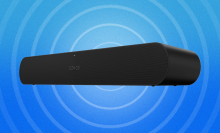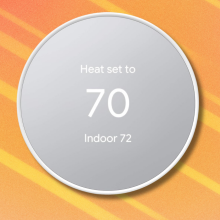Since its launch in 2016, Google Home has evolved from a glorified speaker with an inbuilt voice assistant to a full-blown smart home hub. It can now read off your daily schedule and even start your coffee machine before you get out of bed. But its growth over the years has been on the software side of things. Before Google introduced its new and rebranded Nest Audio smart speaker last week, the device's design had remained completely untouched for four years.
At $99.99, the Nest Audio is now not only more affordable than the original, but it finally has an entirely new look that's far more aesthetically pleasing and contemporary than its predecessor. And, with some upgraded parts under the hood, it also has a fuller, clearer sound as compared to the original Google Home.
Prior to the launch of the Nest Audio, the company had been pumping out new Google Assistant- powered connected home devices left and right — whether that was the Nest Mini, the Google Home Max, or the Nest Hub smart displays — giving consumers plenty of new options to choose from. Those looking for something a bit more powerful than a mini smart speaker and less intense (and cheaper) than the Google Home Max, however, only had an old Google Home model to choose from.
Even Google knew it was time for a refresh.
While undoubtedly new, the Nest Audio doesn't quite revolutionize the rest of Google's smart speaker lineup — it adapts to it instead. To piece together what is now known as the Nest Audio, the company essentially cherry-picked features from the rest of its smart home lineup, like the cloth-covered aesthetic, compact form factor, and intricate audio features (like Ambient IQ and Media EQ) that automatically tweak the sound based on your environment and noise around you.
But don't let the revamp (and producer Mark Ronson's stamp of approval) fool you. While it has its perks in terms of its premium feel and its ability to double as both an audio speaker and a smart home hub, Google's latest smart speaker isn't meant to compete with the likes of Sonos or Bose. The Nest Audio is a smart home device first and a speaker second.
A very necessary face lift
When the Google Home first came out, the memes and tweets poking fun at this thing for its striking resemblance to a Glade air freshener were seemingly endless. And, they weren't wrong — its slightly angled top and curved base makes it look like it's about to spray puffs of some floral scent into the air.
There's no getting around it: Google Home is ugly.

For the Nest Audio, Google scrapped the Home's form factor in favor of a rectangular shape with soft, rounded edges. It's completely covered in fabric, aside from the rubber base on the bottom, which gives it a super clean and seamless look that makes it easy to incorporate into any type of decor.
The Nest Audio also comes in some fun colors like sky, sage, and sand along with more muted ones like chalk and charcoal. As you can tell from photos, Google sent me the chalk color which is certainly easy to match with any interior, but I was really hoping to check out one of the more colorful options.
Seeing as how Google recycled the design from the fabric-wrapped Nest Mini and Google Home Max, the new Nest speaker looks right at home (ha, see what I did there?) alongside both. So, if you own either of those speakers, your setup will look a lot more cohesive.
Like its buttonless speaker siblings, you operate the device by using touch controls: Lightly tap the right corner to raise the volume and the left to lower it. A middle tap will pause or playback audio.
While I've been mainly using voice commands to control it, the touch controls are really responsive. It's also nice that you don't have to place your finger on a specific spot each time for it to recognize the action. It'll register your tap so long as you're within range of each of the corners.
Now, all of that sounds swell, but here's the weird thing: The Nest Audio looks incomplete on its own. I mentioned this in my hands-on, too, but its compact size and small footprint almost begs for another one to be placed alongside it.

And I'm not crazy for feeling that way because Google did say that you'll want to use it in pairs for the best experience. But that's mainly because it has a pairing feature which allows you to connect two Nest Audios for stereo sound.
That doesn't mean you should buy two on the spot, though. Unless you do plan on pairing the two, I can confirm that after spending a week with the speaker, my desire to pair it is slowly subsiding. I'm not fully there yet, but I'm getting more comfortable with letting it stand on its own.
Whatever you do, though, just make sure you don't place this speaker in your bathroom or outdoors. Since it's not waterproof, it's best to contain it to rooms where it won't be exposed to excessive moisture.
Controlling your smart home remains the same, mostly
For those unfamiliar with the Google Nest lineup, all of the smart speakers connect to the Google Home app. It maps out all of your connected devices throughout the house, allowing you to not only keep track of all of them but to also control each one if you're too far away.
As far as smart home controls go, the Nest Audio comes with the standard capabilities: You can ask the Google Assistant questions and trigger commands like "Hey Google, turn the volume up to a five," or "Hey Google, set a timer," link third-party electronics that come with Assistant integration, and stream music or podcasts.

Google claims the Assistant now responds twice as fast compared to its performance on Google Home, since the Nest Audio packs a machine learning chip inside. While I don't have the original to compare, I did find the Nest Audio was quick to respond to my voice. It didn't have trouble understanding my commands either — whether I was requesting songs, asking questions about the weather, or initiating my bedtime routine. In fact, there was rarely a time I had to repeat myself, expect for when I had to speak up a little louder from a nearby room.
If you have more than one Nest smart speaker (any model from the lineup), you can also use features like stream transfer, speaker groups, stereo pairing, and multi-room audio control — all of which can be set up through the Google Home app.
With stream transfer, you can quickly switch whatever you're currently listening to from one Nest speaker to another using either a voice command or the app. Not only is it my favorite feature of the bunch, but it's the one I used most often. It also makes sense to use if you have two speakers at home. Since I tend to move from room to room a lot throughout the day, it allowed me to easily switch whatever I was listening to from my Nest Audio to the Nest Mini, and vice versa.
Each time I left my Nest Audio in my room and moved to the kitchen which houses the Nest Mini, I'd say "Hey Google, move to the kitchen speaker," and it would automatically continue playing my podcast in the next room. Sometimes, if I forgot to request the speaker switch before leaving the room, I'd just tap on the "Play music" option in the app and it'd transfer the content to that specific speaker.
Meanwhile, a feature like multi-room control is a lot more useful if you have a smart speaker in almost every room of the house. You can use it to control the volume of each one right from your phone without having to manually go into each room to either increase or decrease it. But it's also a capability that makes a lot more sense to control on the Nest Smart Display, which offers an easier interface for each device.
The same logic applies to speaker groups, which allows you to group specific speakers together so that you can play audio simultaneously on all of them throughout your space.
But if you're trying to amplify the sound in one room, then you're better off using stereo pairing. I mean, sure, you can group a Nest Audio and a Nest Mini with the stereo group feature and place them next to each other, but it's going to sound unbalanced.

With stereo pairing, you can only pair two of the same speakers together. So, in this case, you'd have to buy two Nest Audio devices for fuller stereo sound. That also means you can control them simultaneously as well through voice commands and on your phone. Ideally, this would work best in whatever room you have dedicated to home entertainment.
You won't be bragging about the audio quality
I'm not an audiophile, but having used the Google Home religiously for three years, I immediately noticed that the Nest Audio's sound is clearer and less muffled by comparison.
Google Home features a 50mm full range driver on the front. Since its job is to reproduce the frequencies of content you're listening to, it uses passive radiators to give you greater levels of bass. But that also results in a muffled sound that isn't as crisp as the Nest Audio.
With the Nest Audio, Google has removed passive radiators from the equation. Since the Nest Audio has a 75mm woofer for bass, it has the ability to access the entire frequency range and provide more depth of sound without the need for passive radiators. So when audio comes through, all you hear is pure bass from the woofer which results in more precise sound.

But while the less muffled sound was enough for me, it's not enough to put this speaker's overall audio quality on par with other higher-end smart speakers.
Mashable's Australian editor, Caitlin Welsh, also tested the Nest Audio out with the help of her partner who is a sound engineer. When I asked for her partner's feedback, she said he found the sound to be "pretty flat and lifeless." He also noted that the Nest Audio's "high-end is completely undefined, the mids are cluttered, [and] the low-end has a bit of a 'whump' ... [that] doesn't really serve the music beyond making it more present."
So, if you're looking for a speaker that's capable of producing a deeper and richer sound, you might want to look at brands like Sonos or Bose that are more well-known for sound quality than features. But if you want to stay within the Google Home ecosystem, then the Google Home Max is another viable option. Of course, at $400, it's much more expensive than the Nest Audio, but you're essentially investing in both quality and features.
Speaking of features, the Nest Audio includes the same Media EQ feature Google first introduced with the Home Max. This measures the acoustics of the space the smart speaker is located within and then adjusts the audio accordingly. But you also have the ability to manually adjust treble and bass via the Nest Audio's settings. So, that might help those of you who are more particular about fine tuning your sound to get it just right.
It also comes with Ambient IQ which adjusts the volume of the content you're listening to depending on the background noise in the room. So, essentially, the closer you move the Nest Audio to "the source" of noise, the louder it will get. However, Google says the feature is only active for particular content — e.g., if you're listening to Google Podcasts, Pocket Casts, or Google New (Google hopes to add Spotify compatibility in the future). But it does work with any background noise like a fan, hairdryer, electric toothbrush, electric razor, vacuum, or running water.
I tested Ambient IQ out with my hairdryer turned on while listening to a podcast at 50 percent volume and can confirm the volume did get louder. But it was still tough to hear clearly. It wasn't until I turned the hairdryer off, increased the volume to 70 percent, and then turned the hairdryer back on that Ambient IQ kicked in loudly enough for me to hear the podcast comfortably.

The feature also worked well with Google Assistant — sort of. After I said "Hey Google, what's the weather?" the Assistant's voice was certainly loud enough for me to hear the forecast. That said, I did have to get as close to the speaker as possible for it to "hear me" over the hairdryer and podcast audio.
Ambient IQ is certainly a nice-to-have feature, but it does take some patience to understand its quirks. And while I love my podcasts, it'd be nice if the feature also worked with music in the future, as well as more third-party apps.
A simple but necessary upgrade
After spending a week with the Nest Audio, I still feel the same way I did when I'd only used it for 24 hours: It's for Assistant loyalists.
For someone like me, who has been using the Google Home for years now, Google has made all the right improvements: It looks nicer, sounds better, and is more affordable. But again, if high-end sound is what you're after, then you're better off looking at speakers from the likes of Sonos, Bose, or Marshall.
Those of you looking to upgrade from the original Google Home really can't go wrong with the Nest Audio. At $99, it's more affordably priced than the $129 you likely spent on the Home years ago. It's also an excellent option to consider if you're looking for a simple smart speaker hub to connect and control all of your smart home devices.
From its easy setup process to its compatibility with a wide range of third-party smart devices, my overall experience with Nest Audio has been seamless. And, seeing as how I'm not the pickiest with sound quality, the improvement in sound clarity is more than enough for my ears.
But that's not to say Google is excused for waiting so many years to upgrade its main smart speaker. Aside from the engineering under the hood, these upgrades aren't all that complex and were long overdue.
Yes, I am very content with Nest Audio and will be for a while, but I truly hope we don't have to wait another four years for its successor.
Topics Google Google Assistant






















